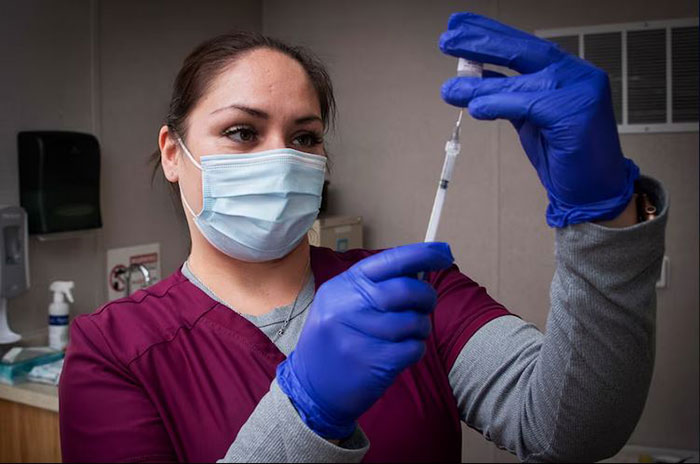Department of Defense Transitions Legacy Special Immunization Program to Commercial Partners

Some professions are inherently risky—and for military personnel, first responders, and medical providers, special precautions are required to safely perform their duties. The same holds true for people who study infectious diseases with the aim of developing medical countermeasures to protect U.S. troops and the general population.
Fort Detrick's Special Immunization Program (SIP) began over 60 years ago to provide an additional measure of protection for military and civilian laboratory workers against occupational infections. For decades, the Department of Defense (DoD) invested in the SIP to provide both licensed and investigational vaccines to personnel at risk of exposure to infectious diseases not typically found in the United States, including tularemia and Rift Valley Fever. Over time, the SIP extended the use of its investigational vaccines to laboratory workers and first responders throughout the U.S. and Canada.
The program included several Investigational New Drug (IND) vaccines produced by the Salk Institute beginning in the mid-twentieth century, according to Tami Pratt, SIP Program Manager for the U.S. Army Medical Materiel Development Activity (USAMMDA), Force Health Protection Division (FHP). In recent years, these vaccines were offered under Food and Drug Administration (FDA)-approved clinical protocols as adjunct protection to other safety measures, including personal protective equipment and training.
DoD's Joint Program Executive Office for Chemical, Biological, Radiological and Nuclear Defense (JPEO-CBRND) partnered with USAMMDA to support the program. The JPEO-CBRND's Joint Project Lead for CBRND Enabling Biotechnologies (JPL CBRND EB), a major stakeholder, managed storage, distribution, and funding for testing of the vaccines. Together, the two organizations maintained and updated the SIP roster of vaccines on a regular basis.
After years of rising costs, dwindling supplies, inconsistent use, and increasing regulatory constraints, DoD leadership made the difficult decision to discontinue the program. To continue the long-standing SIP legacy and to best maintain the safety of at-risk laboratory workers, USAMMDA solicited commercial development licenses for the vaccines. Upon review of submitted applicants, Defender Pharmaceuticals and Sabin Vaccine Institute were selected in 2023 as the companies to oversee the next phase of the program, allowing for the preservation of decades of knowledge, material, and safety protection.
"Transitioning the program was a team effort that took a significant amount of coordination, flexibility, and cooperation," said Pratt, noting that the USAMMDA team worked with JPL CBRND EB and various offices within the U.S. Army Medical Research and Development Command to complete the transition.
In July 2023, USAMMDA executed an exclusive license agreement to transfer the Investigational New Drug regulatory sponsorship and all associated SIP products to the two companies with the intent to commercially develop multiple vaccines. The transition marks the end of DoD's role in managing the program and opens additional opportunities for the program under commercial management.
"It's important to remain agile and make decisions according to what is needed to combat future threats and help the Nation respond rapidly to biological incidents," said Bruce Goodwin, Joint Project Leader for CBRND EB. "At this point, SIP is more of a legacy program that can be managed by our partners in the commercial space. It gives us time and resources to refocus on what's next in the world of biodefense and how we can protect the Nation against evolving threats."
Both the Army and JPL CBRND EB are focused on addressing the problems of tomorrow as quickly as possible, according to Goodwin. This means investing in programs and processes that allow rapid response to changing needs, applying lessons learned for continuous improvement, and keeping the defense community's requirements at the forefront. Maintaining that posture takes foresight, strong partnerships, and agility.
"Biological incidents have the power to produce large and costly ramifications, as we saw during the COVID-19 pandemic, so focusing on the unknowns fits into the JPL's strategic vision," said Goodwin. "We are ensuring that we are making sound investments in future programs—and if a government-sponsored program can thrive elsewhere, we owe it to the country and taxpayers to support that transition."
"Transferring the SIP portfolio to the private sector in lieu of destruction is a 'win-win' for us," added Pratt. "The agreement not only provides for potential royalty fees but will continue the more than 60-year legacy of the SIP—potentially expanding the availability of these products and continued safety to at-risk workers as well."
With that said, the transition is somewhat "bittersweet," according to Chris Spiridon, Acting Deputy Director for Advanced Technology Platforms, and former Assistant Product Manager for JPL CBRND EB's funding line supporting SIP. "This program has been a part of the DoD's portfolio for a long time, and provided additional protection to at-risk personnel where there were limited other options," he said. Spiridon said repurposing SIP funding is just one example of JPL CBRND EB's strategy to be rapid, resilient, and operationally relevant.
"Though we are closing the SIP, one thing remains the same," concluded Pratt. "You can rest assured that our Army and Department of Defense organizations will continue to collaborate and innovate to provide the best possible care to the Warfighter, both now and in the future."













